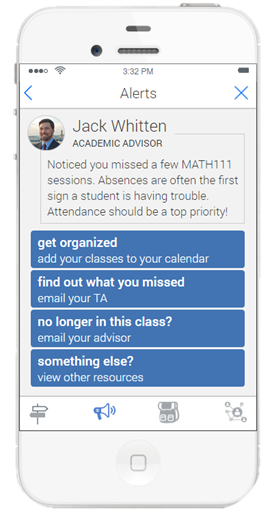You have /5 articles left.
Sign up for a free account or log in.

An example of how a student success management system helps advisers deliver personalized support to students.
EAB
ERP, LMS, SIS -- and now SSMS?
Colleges need enterprise-level systems -- not narrow, problem-specific technology products -- to improve student persistence and job placement rates, the technology and research company EAB argues. Such a system, the company suggests, could be called a “student success management system.”
EAB, a division of the health care-focused Advisory Board Company, based in Washington, D.C., has coined (and trademarked) the term, and said this morning that it intends to compete in a market of such systems. In an announcement that outlined what it sees as an emerging educational technology product category, the company pitched EAB Campus, its bundle of software and management strategies, as the first of what it “fully expects” will be many competing offerings in the space.
Others vendors are welcoming EAB to a market that they say already exists.
“We’ve been talking about the student success platform for years,” said Mark D. Milliron, co-founder and chief learning officer of Civitas Learning. “This is a thing.”
Civitas is likely not the only company to balk at EAB’s claim of “first.” In its most recent report on the higher education ed-tech landscape, Eduventures, a consulting and research firm, placed more than two dozen companies under the umbrella “student success and retention solutions.” Many of those vendors, however, don’t offer enterprise software, but focus on a handful of services -- Chegg on online tutoring and jobs, for example, or Starfish on student retention.
As the number of recent high school graduates heading to college shrinks, colleges are showing a growing interest in software that promises to improve retention and completion rates. In a report published last year by the investment banking and strategy consulting firm Tyton Partners, 44 percent of more than 900 colleges surveyed said their spending over the previous three years on academic planning and advising software had gone up. Few reported declines.
The announcement is in some ways a formalization of the work EAB has been doing for years. The company studies how members of its Student Success Collaborative, a group of colleges and universities, are working on improving student outcomes, and its research has helped colleges prioritize their resources to maximize the impact.
Ed Venit, senior director of strategic research at EAB, said data from members of the Student Success Collaborative suggest that the most successful SSMSes work like souped-up customer relationship management systems, looking at data gathered from previous customers -- or in this case students -- to create models that predict future behavior.
The very best systems, he said, make those models available on a platform that fosters collaboration between advisers, financial aid officers, tutors and others on campus, and actively involve students in academic and career planning.
Broadly speaking, Venit said, EAB Campus aims to do four things: bring as many students as possible back for new semesters (or ensure they graduate), maximize the number of credits students pursue and complete, and boost the share of students who land a job that requires the degree they earned in college.
The system does so both by flagging issues and encouraging students to take action. For example, if data show that students who earn a bad grade in a specific introductory science course go on to struggle as science majors, it flags current students exhibiting those warning signs to advisers, who can then contact the students to get them back on track. Beyond serving as an early-warning system, the SSMS might ask a student about their interests and suggest fitting majors, walk students through financial aid processes or surface a course that could let students graduate early or on time, screenshots shared with Inside Higher Ed show.
“This is not a product announcement -- it’s an announcement of a product category,” Venit said. “There’s a best way that the best colleges are doing this -- looking at metrics, linking technologies, expanding the user base. … It’s a signal to the market that this is an answer.”
Giving Students a ‘Fighting Chance’
Many colleges use student success tools on campus, but only a handful have had institutionwide systems up and running long enough to draw conclusions about their impact.
For EAB, Georgia State University “leads the way,” Venit said. The university is often recognized for its improved completion rates. Compared to five years ago, the university graduates about 1,700 additional students a year. It has closed the achievement gap between students of different ethnicities and dramatically increased the number of black and Latino students who graduate with STEM degrees, Timothy Renick, vice president for enrollment management and student success, said in an interview.
Georgia State’s system -- a combination of software from EAB and other vendors -- last year helped schedule more than 52,000 face-to-face meetings between students and advisers to solve potential issues it had flagged, such as a student signing up for the wrong courses or earning a low grade in a major requirement.
“We didn’t correct 52,000 problems, but I can say five years ago those were issues students were facing … and nobody was noticing, nobody was doing anything,” Renick said. “Unless the student had the personal wherewithal or the family connections to help them through the morass, a lot of them were getting stuck and dropping out. Now we’re at least giving them a fighting chance.”
Technology isn’t the only reason why Georgia State has been able to increase its graduation rate, Renick stressed. The university has also hired about 100 new advisers over the past five years.
“What we’re talking about here is trying to fill a gaping hole in our support for students that has been allowed to exist for too long,” Renick said.
The University of South Florida has a similar list of accomplishments. Over the past five years, the university's six-year graduation rate has climbed from about 50 percent to 70 percent, and its first-year retention rate sits at about 90 percent, said Paul Dosal, vice president for student affairs and student success.
Dosal credited the improvements to a “whole lot of different programs and initiatives,” but said the university’s partnership with Civitas helped it move past a “performance plateau” on which it had been stuck for the past few academic years.
Working with Civitas, USF created a committee known as the Care Team with members from different administrative offices on campus. Members of the Care Team intervene when students face academic, financial or other issues that threaten to derail their studies.
Dosal said that using data analytics to predict the behavior of tens of thousands of students has curiously made the university’s approach to student success more personal, as it makes advisers, financial aid officers and other support staffers more aware of issues students may be facing.
“It’s making our very large university feel a lot smaller,” Dosal said.
Milliron said he views student success management systems as the “third wave” of technology infrastructure for higher education, following enterprise resource planning and learning management systems.
“If we do it right, it’s probably going to enable -- and I don’t think this is hyperbole -- a golden age of learning,” Milliron said. “This should not just be helping at-risk students. It should be helping all students.”




